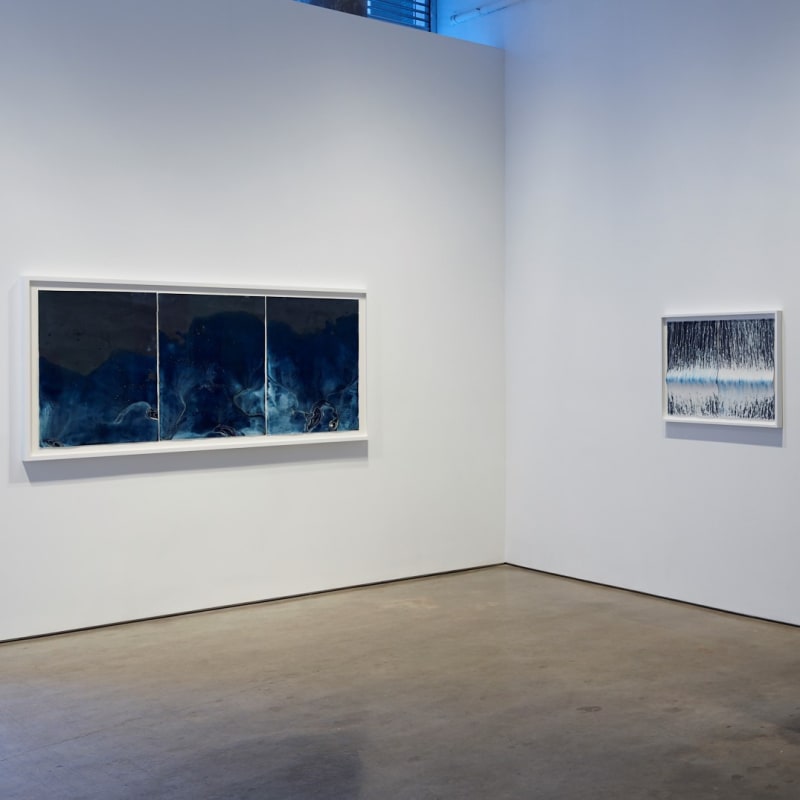While contemplating the drifting water in the cyanotypes of Meghann Riepenhoff displayed on my laptop, I was at once pulled back a century into a scene in Thomas Mann's novel Doctor Faustus (Vintage Books, 1999 [1948], Translation byJ. E. Woods). It was as if I was the father of the protagonist, sit ting in front of a little window frosted with crystals, examining their structure for hours. For these crystals "[...] mimic
plant life with impudent legerdemain, to fake the prettiest fern fronds and grass es, the chalices and stars of flowers, for it to play the icy dilettante in the organic world [...]" (p.21). That was what he could not get over, what set him shak ing and shaking his head in something like disapproval, but also in admiration. "Were these phantasmagorias an imita tion of plant life, or were they the pattern for it?"That was his question, and is mine too even if the matter of, and for, our contemplation is slightly different.
How is it possible that the water re verberates so truthfully from the texture and structure of Riepenhoff's images? Are they photographs? Hydrographs? Or at the end a mere blueprint of the artist's gestures and, therewith, her imagination?
The cyanotype process involves sheets of paper that Riepenhoff sensi tised with a light-sensitive emulsion of an iron complex and citric acid, which, when dried, is ready to expose. Placed on the shores of Bainbridge Island (near Seattle) and Sausalito (near San Francis co)- her two homes-partially poured with and/or buried in the beaches' sand and exposed for the duration of up to five waves, Riepenhoff registered all of it: time, place, light, water, sand, salt, silt, and her all-embracing gestures.
The developing and fixing of cyano types is carried out byonly one step: the washing in water. It removes all the soluble chemicals leaving just the blue image embedded in the structure of the paper's fibre. What we tend to forget is the crucial role the liquid plays in the development of all analogue photo graphs in confrontation to the "[...] glassed-in and relatively "dry" charac ters of the institution of photography" as Jeff Wall's short essay 'Photography and Liquid Intelligence' (in Jeff Wall: Selected Essays and Interviews, 2007, p.109) elucidates so poignantly. To Wall, water represents an archaism in photography, embodying"[...] a memory-trace of very ancient produc
tion processes-of washing, bleaching, dissolving[...]" that evokes as a kind of echo the prehistory in any photo graph. Strictly, all these photographs are coevally hydrographs.
It is Riepenhoff's presence and usage of this process that renders these images in a contemporary time frame. Apart from that, their material and subject matter recall a rather dateless being, still developing, as the seawater did not fully 'fix' or stabilise these images-hence their characterisation as 'dynamic cyanotypes'. They bring the performative dimension of the developing process to the fore by admitting their own imper manence and by capturing the artist's movements on the light-sensitive sur face. The extraordinary size of some prints enlarges also the dimension of handling while lifting the paper in and out of the seawater, involving the help of a second person. The dynamism of this photographic 'piece' is therefore rooted in Riepenhoff's choreography while engaging with the paper and nature. I deliberately call these photo works piecesas it even more underlines the idea of a photographically recorded performance, rather than its mere spa tial installation.
Margaret Olin states in herbook Touching Photographs (2012) that the 'massaging gesture' performed in the darkroom is one of the few photo graphic gestures that actually registers on the print. To her, "[...] photographic gestures indicate that photographic practices do more than merely represent the world. Gestures turn photographs into presences that populate the world like people and act within it to connect people"(pp.13-14). Riepenhoff's works connect us to the very nature of water by offering us its tangible blueprint.
So are the phantasmagoriasof Littoral Drift at the end an imitation of water, or are they the actual pattern of it?
"Neither, he presumably replied to himself; they were parallel formations. Nature in her creative dreaming, dreamt the same thing both here and there, and if one spoke of imitation, then certainly it had to be reciprocal."
-Text by Caroline von Courten

